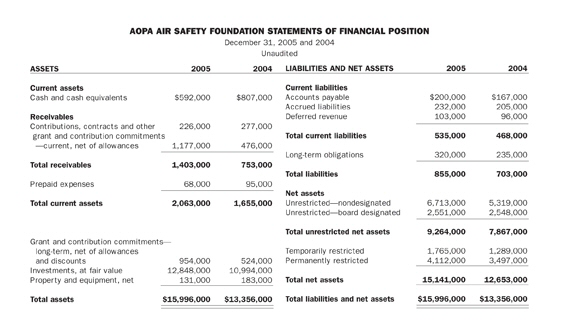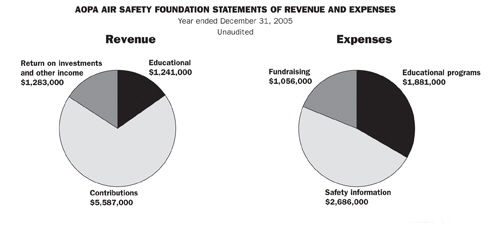AOPA Air Safety Foundation 2005 Annual Report
On Safer Winds
AOPA Air Safety Foundation leverages latest education techniques to improve safety
Tailwinds are gradually improving general aviation's safety record. Looking back to 2004, the new Joseph T. Nall Report (an annual look at light fixed-wing GA aircraft accidents, named after a former NTSB member who died in an aircraft accident in Caracas, Venezuela) shows that GA safety improved in most major categories. There were 6.7 percent fewer total accidents (1,413 in 2004 vs. 1,514 in 2003) in fixed-wing aircraft. Fatal accidents declined by 7.1 percent (to 290 from 312), and fatalities were reduced by 8.4 percent (to 510 from 557). These reductions are even more impressive considering the FAA estimated that GA flight hours have increased by about 200,000 hours in each of the past three years.
However, in 2005 preliminary reports show a slight increase in total and fatal accidents and rates. We believe trends are better indicators than short-term swings; so the Air Safety Foundation tracks a broad base of indicators over five- and 10-year periods, and the trends are continuing down. Much like the stock market, one-year totals are not necessarily a good long-term predictor of the trend — that's why the Air Safety Foundation takes the long view. Despite positive pronouncements, any increase in accidents is cause for concern and shows that there is still plenty of safety work to be done — and it takes a community effort. Safety information, like medicine, does no good unless it is consumed. 2005 was a banner year for the Air Safety Foundation as more safety education products were consumed by more pilots than ever before. ASF produced more live safety seminars, online safety seminars, and GA accident analysis than ever.
A primary means of reaching out to the pilot community was through more than 200 live seminars around the country, which were attended by more than 34,000 pilots. This marks the second decade of partnership with the FAA Safety Program, where the foundation, assisted by local FAA personnel and pilot volunteers, conducted more than 200 programs. The Air Safety Foundation is most appreciative of the FAA's support and cooperation. ASF produced two completely new courses, The Last Five Miles and Do the Right Thing: Decision Making for Pilots.
In 2005, a record five new online courses were launched and nearly 80,000 course completion certificates were issued. If you haven't tried one of these courses, you're missing a whole new learning experience ( www.asf.org). These highly interactive and entertaining programs won several industry awards for creativity and interactivity. New titles include: Mission: Possible — Navigating Today's Special Use Airspace; Mountain Flying; WeatherWise: Ceiling and Visibility; Runway Safety for Commercial Pilots; and Engine and Propeller. The various courses were funded in partnership with the Department of Defense, U.S. Air Force, the FAA, National Weather Service, Teledyne Continental Motors, Hartzell Propeller Inc., Cessna Aircraft Co., and Textron Lycoming.
A new online product — the "Minicourse" — was introduced to provide a quick online education product for busy pilots. New in this category in 2005 were: the VFR GPS Guide: Garmin 430/530; The Pilot's Guide to the Visual Warning System (a must if you are going to be flying near the Washington, D.C., ADIZ); and Thunderstorms: A Case Study.
Although tremendous effort goes into both live and online products, print publications are still a key method of communicating to pilots. The Air Safety Foundation produced or revised its Safety Advisors on topics such as airspace, mountain flying, aeronautical decision making, and engine operations, and 29,000 copies were downloaded from the ASF Web site. Nearly 20,000 print copies were distributed at safety seminars, by mail, and at shows. The Air Safety Foundation takes a comprehensive approach to education so that when a live seminar is presented, participants are given safety documents to take home and review to reinforce learning.
Continuing as the industry leader in recertifying flight instructors, more than 10,000 CFIs renewed with ASF by attending a live course or participating online through the Air Safety Foundation/Jeppesen partnership program — more than any other provider. And, in keeping with our tradition for innovation, the Air Safety Foundation was among the first to offer the required TSA security awareness training — mandatory for all flight instructors.
Accident analysis
With the continued support of the NTSB, the FAA, and the Emil Buehler Trust, more pilots than ever were able to learn hard lessons from others via the AOPA Air Safety Foundation Accident Database.
In 2005 almost 400,000 accident case studies were downloaded — three times as many as in the previous year. New online features include a keyword search and the ability to search by airport. These data are not available from other sources in such an easy-to-use format.
Despite the positive trend in accident rates reflected in the latest Nall Report, we're facing headwinds in making additional progress in this category. By the close of 2005, as mentioned earlier, the overall accident rate showed a slight uptick so, clearly, our work is not done. Pilot error still accounts for more than 75 percent of the total accidents and 78 percent of the fatal accidents — these number have not changed much in decades.
Weather-related fatalities remain a problem. Several involved thunderstorms, and the majority of pilots were talking to air traffic control — obviously we're having a communication problem. By the time you read this a new online course will be available to help pilots better leverage ATC services to avoid thunderstorms. In single-engine fixed-gear aircraft, the majority (90.5 percent) of weather-related accidents were caused by pilots attempting VFR flight into instrument conditions. This remains an ongoing problem area.
ASF currently offers three weather-related online courses — WeatherWise: Ceiling and Visibility; Single-Pilot IFR; and SkySpotter — and multiple safety publications that educate pilots about weather and sound decision making while in the weather. And in 2006 we plan to increase our weather education with two new online weather courses — the second in the WeatherWise series and a new updated SkySpotter.
Another often overlooked but essential component of the Air Safety Foundation's outreach is the Pilot Safety Series DVDs that are sent free to new private and new IFR pilots. In 2005 some 38,000 pilots benefited from this unique and proactive approach. This project has been funded in the past by AOPA with special assistance from the FAA to distribute by mail. Going forward, a significant grant from a major benefactor, Ned Bennett, will help continue this critical education series. The topics focus on crosswind landings and cross-country navigation for private pilots and on weather for new instrument ratings.
By far the strongest headwind ASF encounters every year is the fight for pilots' attention. Carving out an hour to take an online program or a few hours to attend a live seminar is difficult these days but essential, which is why ASF designs our educational material to be focused, relevant, and entertaining. You owe it to yourself and the entire general aviation community to invest this time to improve your safety education. We can't promise you tailwinds on every flight, but we can promise you'll fly more confidently when armed with the latest safety education materials provided by the AOPA Air Safety Foundation.
![]()
Bruce Landsberg
Executive Director
AOPA Air Safety Foundation
www.asf.org


Finding the Jet Stream
In 2005 AOPA members donated more to the AOPA Air Safety Foundation than ever before. We anticipated headwinds against our telephone fund-raising campaign with the new do-not-call lists and spreading call-blocking technologies. We appreciate your understanding in how important this technique is to the success of ASF. From AOPA members at all flight levels and financial levels, the tailwinds were with aviation safety. In fact, nothing could dissuade our loyal members from making their renewed contributions.
In 2005 we added nearly 100 new AOPA Life Members. Life membership is offered exclusively through the AOPA Air Safety Foundation by a generous one-time payment of $2,500, of which a tax receipt is provided for the $2,000 charitable portion. This very special group receives a lifetime of full AOPA member benefits, along with the pride of being among the first 1,000 AOPA Life Members.
To further grow resources in support of our safety education efforts, we initiated the newest high-level society in GA, the AOPA President's Council, not knowing the prevailing winds for such a large donation. The new AOPA President's Council, with Honorary Chairman John Nordstrom, AOPA 1177592, which requires that a $50,000, or higher, donation be given within five years, enrolled more than twice the number of charter members as anticipated. The resounding success provided new tailwinds in 2006 for more growth toward the goal of 100 Charter Members.
Sometimes the headwind an organization faces is itself! For more than 15 years the prestigious Hat in the Ring Society asked pilots for a tax-deductible donation of $1,000 — no more. Last year, we found that the only headwind holding the Hat in the Ring campaign at a firm $1,000 was in our own minds. So, when the AOPA Air Safety Foundation's Hat in the Ring Society offered bronze-level membership for a $2,500 donation and silver level for a $5,000 or higher donation, dozens and dozens of loyal AOPA Hat in the Ring members stepped up to these levels — voicing their annual support for more safety research and education.
Offering guidance on the AOPA Air Safety Foundation's safety programs, and in both giving and raising funds to support the growth of these programs, the prestigious board of visitors' leadership is critical. This cadre of volunteer pilot-philanthropists makes real the following statement: One AOPA equals a safe GA.
On behalf of all pilots and their passengers, we thank you for your support in 2005 and hope those same tailwinds will propel you this year to contribute to a safe GA.
Harvey W. Cohen
Senior Vice President
AOPA Air Safety Foundation


